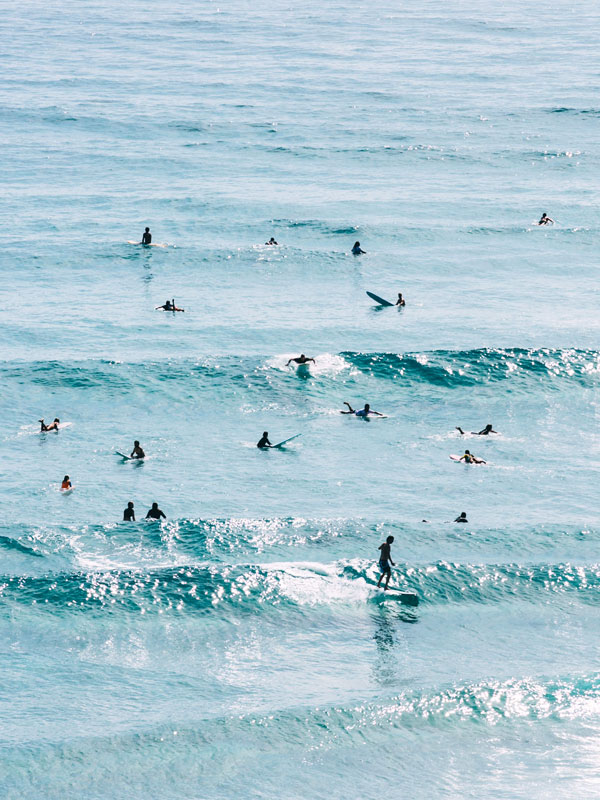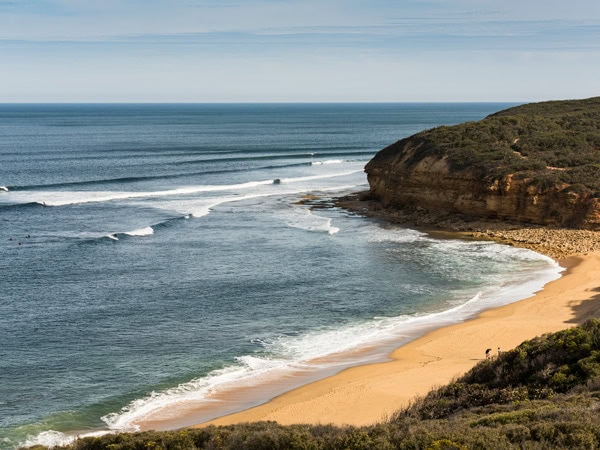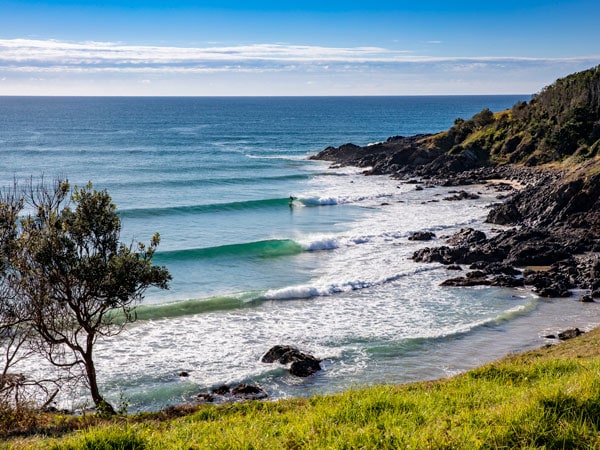30 October 2024
![]() 9 mins Read
9 mins Read

Head down to the beach at daybreak, anywhere the swell is permitted to reach the shore, and you’ll see them. The wetsuit-clad meditators, the board shorts and bikini brigade, the groms and the silver-haired sea dogs with boards under arm, all gathered in their sandy place of worship.
Peeling towards rocky points, butting up against sandbars or curling around artificial reefs, waves break rhythmically on Australia’s coastline in all kinds of conditions. The surf calls to the soul of those who find solace duck-diving into its salty embrace. Those hooked on the indescribable feeling of riding a wave.

Bondi Beach is one of Australia’s most iconic surf spots. (Image: Elise Hassey)
When it comes to the quality of surf breaks, and the sheer number of them that ring the continent, Australia is indeed the lucky country. Surfing took off in Australia after being introduced by Hawaiian Duke Kahanamoku in 1915, its popularity never waning. Australia is renowned as one of the world’s premier surfing destinations and it’s inescapably intertwined in the coastal fabric.

Australia’s surf breaks are the envy of the world. (Image: Elise Hassey)
“Surfing is much more than a sport,” says conservationist Brad Farmer. “It’s a culture, it’s an art form, it’s a pastime, it’s a meditation. That’s why people go to the beach. Billions of visitors go there for this experience, which is really subjective and ephemeral.”

Yallingup is paradise for surfers and sun worshippers. (Image: Elise Hassey)
If Farmer’s name rings a bell, it’s because he’s also the man responsible for declaring the top beaches in Australia each year as Tourism Australia’s Beach Ambassador – a title he’s held since publishing his book 101 Best Australian Beaches with co-author Professor Andy Short in 2013. The annual list is carefully curated to showcase the diversity of beaches Australia has to offer.

Margaret River Surf School runs private surf lessons for all ages. (Image: Tourism Australia)
As a surfer himself, Farmer comes at it with a long history of advocating for Australian beaches. He’s responsible for creating the non-profits Surfrider Foundation Australia and Ocean Care Day, and is working alongside indomitable pro-surfer Kelly Slater to develop a model for UNESCO to recognise significant coastal sites. But it was his work as the founder of National Surfing Reserves that has led to the most profound change in how we value Australia’s outstanding surf breaks and the lifestyle they afford.

Margaret River is a swell magnet in the south-western corner of WA. (Image: Elise Hassey)
The idea to protect surf breaks was seeded in 1973 when a group of local surfers created a ‘Surfing Recreation Reserve’ at Bells Beach, Victoria.

Bells Beach is where pro Mick Fanning won his first-ever World Surf League tour. (Image: Robert Blackburn/Visit Victoria)
At the time, Australia’s surf culture was quickly gaining pace – it was the early days of Rip Curl and a time when shortboards were adopted to surf punchy beach breaks, as opposed to the longboards beloved in places like California. With our remote and untouched landscapes – and the advent of innovative gear such as wetsuits and board shorts that made the game a whole lot more enjoyable – Australia’s surf scene quickly became the envy of the world.

Pick up a secondhand surfboard from the old-school surf shop in Anglesea, Victoria. (Image: Elise Hassey)
Taking the concept of Bells and the power the reserve had held in the face of relentless coastal development, Farmer established the not-for-profit National Surfing Reserves in 2005 under the patronage of rock legend, environmentalist and then Federal Member of Parliament, Peter Garrett.
He had a list – the top surf spots found among about 1100 surfing beaches ringing Australia’s coast – and since Maroubra was declared as the first National Surfing Reserve in 2006, 18 more renowned breaks have been added to the list.
The criteria is strict and the application process can take anywhere from nine months to six years, but ultimately, each successful reserve is recognised as a place of “intrinsic environmental, heritage, sporting and cultural value to our nation”.

Sydney’s Maroubra Beach was Australia’s first National Surfing Reserve. (Image: Destination NSW/Anna Kucera)
In 2009, Farmer helped the non-governmental Save The Waves Coalition take the idea global with the launch of World Surfing Reserves, and in 2016, Regional Surfing Reserves were added, extending to “any local surf breaks that have good waves and the community feel a sense of pride.”
“It’s as much about protecting these sandy spots of worship, as it is about the community around them,” says Farmer. “Empowering those who love and use our beaches, with a say in how they’re managed,” he says. “This is what we call a sacred site – similar to how Indigenous Australians would have a bora ring or midden. The community have a sense that this is a place of awe, there’s something sacred about this particular site, not only for the quality of its waves.”

Yallingup Beach is considered by many as the birthplace of boardriding in WA. (Image: Tourism Australia)
For Australia’s Saltwater people, the First Nations groups born and raised to understand and care for the coast and its waves like no other, the ocean is like family. Indigenous ex-pro and co-founder of the Royal Indigenous Surfing Association, Robbie Page, sees it similarly to Farmer. “Surfing’s a healing place,” he said in the ABC documentary Changing Tides. “It’s got no prejudice, it teaches every human, welcomes every human.”

Freshwater Beach has more than a century of surfing heritage. (Image: Destination NSW/Mark Clinton)
National Surfing Reserves are essentially decreed so that all people can enjoy, understand and protect these special coastal environments. While the volunteer-led National Surfing Reserves has always had people power on its side – and likely the approval of tourism boards who use the reserves in their marketing efforts – until recently, it lacked legal sway.

A surfer ducks under a wave at North Narrabeen Beach. (Image: Destination NSW/Guy Williment)
The movement had been able to persuade the NSW government to gazette surfing reserves in 2007, formally recognising them in the Crown Lands Act. “It was the first time in the world that surfing and surfers had been recognised in any law in any country,” says Farmer.
However, the reserves have since become a springboard for surf communities to read the riot act. Which is exactly what happened in 2020, when there was a threat of over-development at Killalea Regional Park – aka The Farm. “It was fought on the basis of surf reserves, and is now a [protected area] park,” explains Farmer.

Surfers travel to Australia to find a magical break. (Image: Elise Hassey)
One of the key players in this fight was a local surfer called Chris Homer, the then-president of National Surfing Reserves. Leading a record-breaking paddle out to oppose the construction of a 200-seat function centre and 15 cabins inside Killalea Reserve, Homer’s passion and leadership saw him elected as mayor of Shellharbour soon after, even though he had no prior political experience.
“Whether in legislation, or lore, these places are sacrosanct and not to be touched, and the wording is such that surfers will have primacy in the decision-making process,” says Farmer.

Byron Bay in NSW’s Northern Rivers is a wonderland for surfers. (Image: Elise Hassey)
In mid-2023, with a strong contingent of those surfers on the Central Coast, Norah Head National Surfing Reserve welcomed the news that a wind farm proposed off the coast of NSW would no longer include the surf spot. The original proposal had the potential to affect two iconic surf reserves, Norah Head and Merewether – both hotbeds of surfing talent.
Since then, more research has come to light on not only the importance of Australia’s surf breaks from an environmental point of view, but an economic one, too. Surfing is worth almost $3 billion annually to Australia’s economy, according to a recent study by the Australian National University, and that’s making more people in higher places sit up and pay attention.

A surfer paddling at Freshwater Beach, Sydney. (Image: Destination NSW/Adam Krowitz)
Another goal of National Surfing Reserves is to safeguard the continuum of surf culture. City of Gold Coast council even has a detailed Surf Management Plan, which includes programs to teach surf etiquette, to ensure visitors clearly understand local safety customs. Similarly, Noosa has a Surfer Code to reduce the chance of conflict and injury.

Noosa’s pristine Main Beach is a surfing hotspot. (Image: Tourism Australia/Glen Davis)
Surfers, after all, are not just those out riding the waves. The beauty, value and mental health benefits of surfing permeate the desirable beachside lifestyle so many Australians enjoy and visitors yearn to experience.

Local community and surf culture, such as that found in Noosa, are a determining factor in what qualifies as a Surfing Reserve. (Image: Elise Hassey)
Ultimately, whether you’re a hardcore big-wave rider with saltwater in your veins or have no desire to go further than watching the waves with a coffee in hand, understanding and appreciating that these sites have seen quality waves being ridden consistently – in some places for more than 100 years – provides a sense of legacy.

Ride the waves at NSW’s Crescent Head. (Image: Destination NSW/Dallas Kilponen)
Years from now, Farmer believes, these surfing reserves will become akin to national parks and, he hopes, will be protected at all levels, not excluding UNESCO. “I will continue to argue that waves have absolutely unique qualities to humanity – not just to their enjoyment, but they’re a phenomena of nature … and they deserve to be recognised as such,” says Farmer.

Surfboards lined up at Bondi. (Image: Elise Hassey)
I was most proud to have Bondi dedicated and gazzetted as a NSR in 2017. I was encouraged by Andy McKinnon and Rabbit during a visit to Bondi by the Huanchaco WSR team from Peru.
Well written and well covered Celeste and Australian Traveller. Our wave lashed island is, after all, just one big beach. I hope that junior surfers take up the task of ensuring our beaches remain the world’s finest!
Great article. Informative and you have nice way with words.